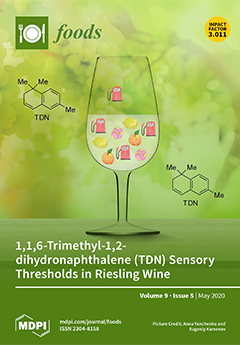Microgreens are gaining more and more interest, but little information is available on the effects of the chemical composition of the nutrient solution on the microgreen yield. In this study, three
Brassica genotypes (
B. oleracea var.
italica,
B. oleracea var.
botrytis, and
Brassica rapa L. subsp.
sylvestris L. Janch. var.
esculenta Hort) were fertigated with three modified strength Hoagland nutrient solutions (1/2, 1/4, and 1/8 strength) or with three modified half-strength Hoagland nutrient solutions with three different NH
4:NO
3 molar ratios (5:95, 15:85, and 25:75). Microgreen yields and content of inorganic ions, dietary fiber, proteins, α-tocopherol, and β-carotene were evaluated. Micro cauliflower showed the highest yield, as well as a higher content of mineral elements and α-tocopherol (10.4 mg 100 g
−1 fresh weight (FW)) than other genotypes. The use of nutrient solution at half strength gave both a high yield (0.23 g cm
−2) and a desirable seedling height. By changing the NH
4:NO
3 molar ratio in the nutrient solution, no differences were found on yield and growing parameters, although the highest β-carotene content (6.3 mg 100 g
−1 FW) was found by using a NH
4:NO
3 molar ratio of 25:75. The lowest nitrate content (on average 6.8 g 100 g
−1 dry weight) was found in micro broccoli and micro broccoli raab by using a nutrient solution with NH
4:NO
3 molar ratios of 25:75 and 5:95, respectively. Micro cauliflower fertigated with a NH
4:NO
3 molar ratio of 25:75 showed the highest dry matter (9.8 g 100 g
−1 FW) and protein content (4.2 g 100 g
−1 FW).
Full article






